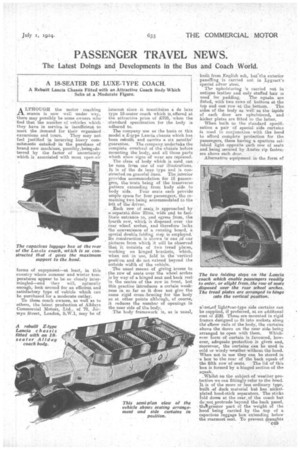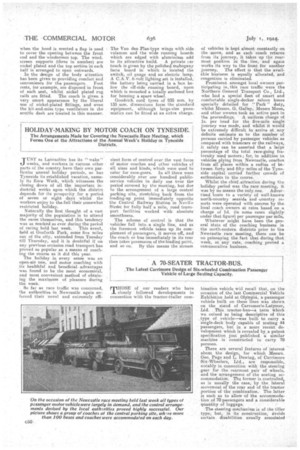PASSENGER TRAVEL NEWS.
Page 37

Page 38

If you've noticed an error in this article please click here to report it so we can fix it.
The Latest Doings and Developments in the Bus and Coach World.
A 18-SEATER DE LUXE-TYPE COACH.
A Rebuilt Lancia Chassis Fitted with an Attractive Coach Body Which Sells at a Moderate Figure.
ALTHOUGH the motor coaching season is now well under way, there may possibly be some owners who find that the number of vehicles which they have in service is insufficient to meet the demand for their organised excursions and tours. They may not feel justified in incurring heavy commitments entailed' in the purchase of brand vow machines, possibly,being*deterred by the factor of uncertainty which is associated with most open-air
forms of enjoyment.—at least, in this country where summer arid winter temperatures appear to be so closely intermingled—and they will, naturally enough, look around for an efficient and :satisfactory type of vehicle which can be purchased for a moderate outlay.
To those coach owners, as well as to others, the latest production of Alidays Commercial Motors, Ltd., of '78, Jarroyn Street, London, S.W.1, may be of
interest since it bonstitutes a de luxe type 18-seater coach which is;offered at the attractive price of £795, when the ;standard specification for the body is adhered to.
The company use as the basis ox this model a Z-type Lancia, chassis which has been rebuilt. and carries a six months' guarantee. The company, undertake the complete overhaul of the chassis before mounting the body, and all those parts which show signs of wear are replaced.
The class of body which is used can be seen from one of our illustrations. It is of the de luxe type and is con
structed,on graceful lines. The interior provides accommodation for 18 passen'gem; the teats being of the transverse. pattern extending from body side to
body side. Four sears each prOvide ample space for tour passengers, the reretaining. two being acconiniodated to the left of th.e driver,
Each row of seatS, is approached by a.separate dbOr Mins. wide and to facilitate entranceto, and egress from, the fourth row, which is disposed over the rear wheel arches, and therefore lacks the :convenience of a running board, a special double folding step is employed. Its donstruction is shown in one of our pictures from which it will be observed that it 'consists of tWo tread i) lates, working on hinged brackets, which, whet not in use, fold in the 'vertical position and do not extend beyond the outside width of the vehicle.
The usual meau.s. of giving 'access to . the_ row of seats over the wheel arches is by way of a hinged seat and back rest hi the centre of the row in front, but this practice introduces a certain weakness in so far as it does not give the same rigid cross .bracing for the body as at other points although, of course, it reduces the number of openings in the near side of the body. The body framework is, as is usual, built from Fn.glish ash, but"the exterior panelling is carried out in Lygsart's special silver steel. ; The upholstering ;s carried out in antique leather and only stuffed hair is
-used for padding. The squabs are fluted, with two rows of buttons at the top and one row at the. bottom. The sides of the body as well as the *side of each door are upholstered, and kicker plates are fitted to the latter.
When built to the standard specification a pair of special side curtains is used in conjunction with the hood to afford complete protection for the passengers, these having a spacious celluloid light opposite each row of seats and being secured by Amster rip fasten: ers above each door.
Alternative equipment in the form of
a'..set,of light...tear-type side curtains can be supplied, if preferred, at an additonal coat of LW. These are mounted in rigid frames designed to fit into sockets along the elhow rails of the body, the curtains above the doors on the near side beim.. arranged to open with them. Whichever form of curtain is favoured, however, adequate protection is given and, moreover, the curtains can be used in cold or windy weather without the hood. When not in use they can be stored in 'a box to the rear of tale back squab of
the fifth row of seats. The lid of this box is formed by a hinged section of the squab, ,Whilst on the subject of weather protection we can fittingly refer to the hood. It is of the more or iess ordinary type, built of duck material but has nickelplated hood-stick separators. The sticks fold down at the rear,of the coach but do'.nokprotrude beyond the back panel, thellgreater 'part dl the wei,glit of the hood being carried .by the :top of a capacious luggage box extending below the rearmost seat. To prevent draughts when the hood is erected a flap is used to cover the opening between the front end and the windscreen top. The wind. screen supports (three in number) are nickel plated and the top section in each half is arranged to open outwards.
• In the design of the body attention has been given to providing comfort and
convenience for the passengers. Foot rests, for example, are disposed in front of each seat, whilst nickel plated rug rails are fitted. The coach is given a very smart appearance by the liberal use of nickel-plated fittings, and even the hit-and-miss type ventilators in the scuttle dash are treated in this manner. The Van den Plas-type wings with side valances and The wide running boards which are edged with aluminium add to it attractive build. A private r ar touch is given by the polished mahogany facia board in which is located the switch, oil gauge and an electric lamp. A C.A.V, 6-volt lighting set is installed, the battery being carried in a box below the off-side running board, upon which is mounted a totally enclosed box for housing a spare wheel.
Goodrich cord tyres of 935 mm. by 135 mm. dimensions farm the standard equipment, -although large-size pneumatics can be fitted at an extra charge.














































